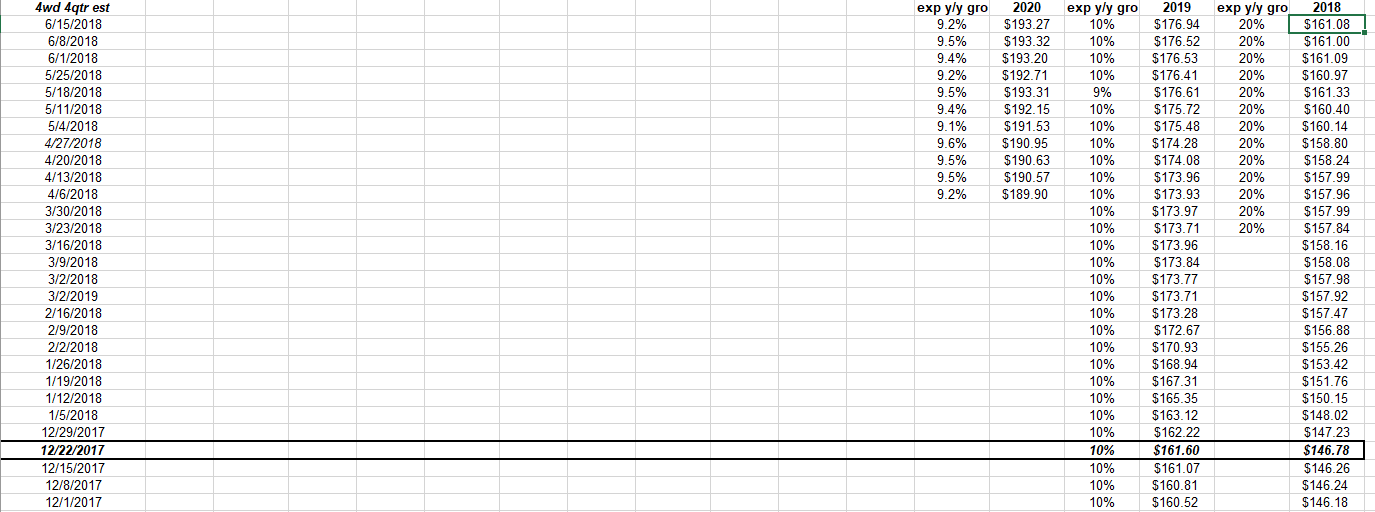Here is 6-year detail (both historical and prospective) of S&P 500 earnings growth:
- 2020: +9% (est)
- 2019: +10% (est)
- 2018: +22% (est)
- 2017: +12%
- 2016: +1%
- 2015: -1%
Source: Thomson Reuters IBES

The Excel table just above shows the chronological progression of the S&P 500’s forward earnings (for calendar years 2018-2020) estimates since the tax reform bill was signed on Friday, December 22nd, 2017 by US President Donald Trump.
It is the “growth rate” that is slowing, not the actual S&P 500 earnings estimate.
If you look at the market corrections of 2000-2002, and then 2007-2008, the absolute level of S&P 500 earnings fell for the index, showing negative earnings growth for those years, but unlike those two periods in the 2000s, negative earnings growth doesn’t always mean negative returns for the S&P 500.
During the 1980s – 1990s bull market, there were three years from 1990 to 1992 that saw negative S&P 500 earnings growth for the S&P 500:
- 1992: S&P 500 earnings fell 12.5%, while the S&P 500 returned 7.6%.
- 1991: S&P 500 earnings fell 3% and the S&P 500 returned 31% that year. Post Gulf War rally for stocks, falling interest rates, Technology and FInancial economy)
- 1990: S&P 500 earnings fell 6%, and the S&P 500 returned -3% in 1990 (First Gulf War, start of commercial real estate crisis)
So for a 3-year period from 1990 to 1992 when S&P 500 earnings fell a cumulative 21%, the S&P 500 returned 35%-36%.
Conclusion:
Ray Dalio and Bridgewater Associates think 2019 could be ugly for financial assets and the bears are out there “bearing” (growling?) in sympathy with Bridgewater. The S&P 500 bottomed in March ’09, and didn’t really make a new all-time-high until 2013, so you could in fact make a good case for the bull market still being fairly young.
As readers can see from the S&P 500 earnings data, the reduction in the corporate income tax rate is driving some of the growth in S&P 500 earnings this year, and it could potentially unlock a longer period of capital investment in the US economy as well. The history of the 1980s and 1990s bull market in stocks was all about “P.E expansion” and market cap leadership, and the same holds true today. With a forward P.E of 17x today, the S&P 500 is still trading well below the 1987 peak P.E before October ’87 and the similar P.E around the high 20’s in early 2000.
That being said – as was written a few weeks ago – don't just look at the S&P 500 P.E ratio. Tracking S&P 500 earnings on a weekly basis is a poor market-timing indicator. Readers who check this site weekly to try and time the market are – with all due respect – playing a fool’s game, since the S&P 500 will lead any change in estimates probably by 6 months or so.
Bridgewater could be very right about 2019 – but the fact too is this market hasn't seen even a decent correction since mid-2015 to Q1 ‘2016 when crude oil bottomed near $28 and high yield credit spreads widened substantially and before that was the 2011, 20% S&P 500 correction from May ’11 to early October, 2011.
Since 2013’s new all-time S&P 500 high, this bull market has been marked with longer periods of stable capital markets and higher stock prices.
With Technology’s current 26% market cap weight in the S&P 500 (and that doesn’t include Amazon (NASDAQ:AMZN) and Netflix (NASDAQ:NFLX), both of which are part of the Consumer Discretionary sector), to have a problem with the S&P 500, you’d have to have a longer-term problem with the Tech sector. With the Facebook (NASDAQ:FB) and social media privacy issues earlier this year, Tech had a pretty good reason to break down and it didn’t.
Remember, Technology, Financials, Health Care and Consumer Discretionary (just 4 sectors) are over 60% of the S&P 500 by market cap currently.
S&P 500 Weekly Earnings Data:
- Fwd 4-Q estimate: $163.97 vs last week’s $163.82
- P.E ratio: 17x
- PEG ratio: 0.78x
- S&P 500 earnings yield: +5.90% vs last week’s 5.89%
- Year-over-year growth of fwd est: +21.77% vs 21.50%
The “forward estimate growth rate” (last bullet point) has been between 20% and 22% for 18 straight weeks, and the forward dollar EPS estimates for the S&P 500 continues to drift higher.
